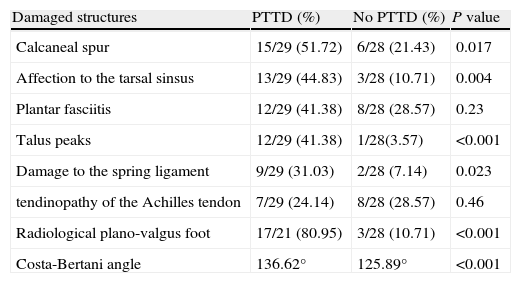To evaluate the association of posterior tibial tendon dysfunction and lesions of diverse ankle structures diagnosed at MRI with radiologic signs of flat foot.
Materials and methodsWe retrospectively compared 29 patients that had posterior tibial tendon dysfunction (all 29 studied with MRI and 21 also studied with weight-bearing plain-film X-rays) with a control group of 28 patients randomly selected from among all patients who underwent MRI and weight-bearing plain-film X-rays for other ankle problems.
In the MRI studies, we analyzed whether a calcaneal spur, talar beak, plantar fasciitis, calcaneal bone edema, Achilles’ tendinopathy, spring ligament injury, tarsal sinus disease, and tarsal coalition were present. In the weight-bearing plain-film X-rays, we analyzed the angle of Costa-Bertani and radiologic signs of flat foot. To analyze the differences between groups, we used Fisher's exact test for the MRI findings and for the presence of flat foot and analysis of variance for the angle of Costa-Bertani.
ResultsCalcaneal spurs, talar beaks, tarsal sinus disease, and spring ligament injury were significantly more common in the group with posterior tibial tendon dysfunction (p<0.05). Radiologic signs of flat foot and anomalous values for the angle of Costa-Bertani were also significantly more common in the group with posterior tibial tendon dysfunction (p<0.001).
ConclusionWe corroborate the association between posterior tibial tendon dysfunction and lesions to the structures analyzed and radiologic signs of flat foot. Knowledge of this association can be useful in reaching an accurate diagnosis.
Valorar la asociación entre Disfunción del Tendón Tibial Posterior (DTTP) y lesiones de diversas estructuras del tobillo diagnosticadas por RM, y los signos radiológicos de Pie Plano.
Material y métodoRealizamos un estudio retrospectivo comparando 29 pacientes con DTTP, todos examinados por RM y 21 de ellos con estudio radiológico en carga, con un grupo control de 28 pacientes elegidos aleatoriamente entre aquellos estudiados por otras patologías del tobillo mediante RM y estudio radiológico en carga.
En los estudios de RM revisamos la existencia de espolón calcáneo, pico talar, fascitis plantar, edema óseo calcáneo, tendinopatía del Aquiles, lesión del ligamento Spring, patología del seno del tarso y coalición tarsiana. En los estudios radiológicos en carga se valoraron el ángulo de Costa-Bertani y signos radiológicos de Pie Plano.
Analizamos las diferencias entre grupos en los hallazgos en RM y presencia de Pie Plano mediante el test exacto de Fisher y del ángulo de Costa-Bertani mediante el análisis de la varianza.
ResultadosLa presencia de espolón calcáneo, pico talar, patología del seno del tarso y del ligamento Spring fue más frecuente en el grupo con DTTP, de forma estadísticamente significativa (p<0,05). También existieron diferencias significativas en la presencia de Pie Plano radiológico y valores anómalos en el ángulo de Costa-Bertani, más frecuentes (p<0,001) en el grupo con DTTP.
ConclusiónCorroboramos la asociación entre lesión de estas estructuras diagnosticada por RM y los signos de Pie Plano radiológico con DTTP. El conocimiento de esta asociación puede ser de utilidad para establecer un diagnóstico preciso.














